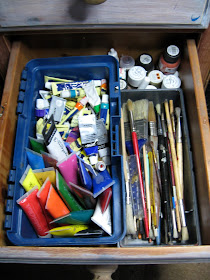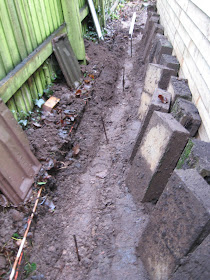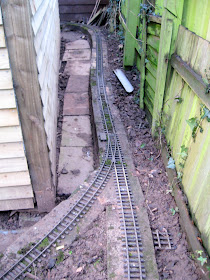 Preamble
Preamble
I run two mixed trains on the PLR in addition to the daily pickup goods. The morning mixed always includes a flat wagon to pick up milk churns from morning milking sessions and stock for any urgent deliveries or pickups. The afternoon mixes is a much more leisurely affair.Once the manifest for each train has been generated by my home-brewed computerised freight management program the Down trains are marshalled at Beeston Market following the railway's freight management guidelines to ensure passengers in the coaches are disturbed as little as possible en route and that a minimum of time is spent shunting at each station.
Because there is inconsistency as to the direction in which the sidings at each station on the railway faces, forethought has to be applied when marshalling wagons, dependent on their intended destination. This may all sound complicated initially, but there is a logical pattern to the placement of wagons in relation to whether they are marshalled before or after the passenger carriages.
Let's examine each station in turn.
Beeston Castle
As can be seen, the two sidings are located on the Down loop of the station. So, when a Down Mixed Train arrives at the station ......
........ the loco would have to propel the whole train back into the Yard siding to drop off any wagons.
Or, to drop off (or pick up) wagons on the Brewery siding, the loco would have run round the train .....
...... and then propel the whole train back into the siding. Both these manoeuvres would inconvenience passengers who would be jostled back and forth in the process.
So, if any wagons are required to be delivered to or picked up from either siding at Beeston Castle, then it is far better for them to remain on the Down Mixed for the entire journey and wait until they return on the Up Mixed to be shunted.
Therefore, wagons intended for the brewery need to be marshalled on to the Up side of the passenger coaches so they can be detached and shunted back into siding ......
...... and wagons which are intended for Beeston Castle Yard, need to be marshalled on the Down side of the coaches so the loco can run round the train .......
...... detach the wagon(s) and shunt them into the Yard siding. After which the loco can return to the train and continue on its way.
These movements cause minimal disturbance to the passengers who would probably detrain and watch the proceedings while puffing on their cigarettes or pipes.
Peckforton
Interestingly, at Peckforton, freight movements on Mixed trains are quite different. This is largely because all the sidings face the Up direction and also because Peckforton station has the luxury of a small diesel pilot locomotive to mainly serve the sawmill.So, when a Down Mixed train arrives ......
..... the pilot / shunter loco removes any wagons destined for Peckforton from the rear of the train .....
...... and shunts them into the Yard .....
.... and/or the sawmill sidings.
Thus causing minimal disturbance for the passengers unless, of course, any wagons need to be attached to the train in which case there will be a short delay.
When an Up Mixed arrives at the station.......
...... any wagons destined for Peckforton are detached by the loco from the front (Up end) of the train and shunted into the relevant sidings.
If there several wagons to be moved then the train loco could leave them on the loop for the pilot/shunter to deal with later, thereby causing minimal disruption to the passengers.
Mill siding
The mill siding is situated between Peckforton and Bulkeley and, like the Mill Sidings on the Southwold and Welshpool & Lllanfair Railways faces Down the line.This means that any wagons on Down Mixed trains intended for the Mill siding need to be marshalled on the Down end of the train ........
Bulkeley
The layout of Bulkeley station is similar to that at Beeston Castle, however two of the sidings are on the Up loop and only one siding is accessed from the Down loop. As a consequence, the arrangements for shunting wagons from Mixed trains is slightly more complicated, dependent on the intended destination siding for each wagon.When a Down Mixed train arrives ........
..... the loco can easily remove wagons from the front of the train to shunt into the Up Yard siding.
Then, by running round the train .......
...... it's possible to detach wagons from the Up end of the train and shunt them into the Down yard.
To shunt wagons into the Boneworks siding, any wagons on the Down train need to travel the length of the line and be shunted when the train returns Up the line.
Wagons on the Up end of the train can then easily be shunted into the Boneworks siding.
Bickerton
The shunting at Bickerton is very straightforward as both sidings face Up the line. When a Mixed train arrives at the station .......... the loco runs round .......
...... and then any wagons which need to be shunted into the Parcels siding ......
.... and/or the Yard siding .........
..... can be removed from the Up end of the train.
Up Mixed trains
The destination of goods traffic which travels Up the line is most likely to be Beeston Market. However, from time to time a wagon might have to be delivered to an intermediate station from further Down the line. In some cases, ie wagons intended for the sawmill, Boneworks or brewery, then it would be relatively easy for such wagons to be delivered via an Up Mixed. However, if a wagon is destined for other sidings then the wagon would have to travel Up the line to Beeston Market and await the next Down Goods or Mixed train.
In summary
The following chart has been devised to guide station masters and guards when marshalling Mixed trains.
Destination
|
Position in Train
|
Beeston Castle Brewery
|
Up end
|
Beeston Castle Yard
|
Down end
|
Peckforton Yard or Sawmill
|
Up end
|
Water Mill siding
|
Down end
|
Bulkeley Down Yard / Boneworks
|
Up end
|
Bulkeley Up Yard
|
Down end
|
Bickerton
|
Up end
|
NOTE: The 1889 Railway Regulations Act requires that the locomotive and coaches must be continuously braked. For this reason, coaches in mixed trains are normally coupled directly to the loco unless intervening wagons are also braked or piped. However, the PLR follows the precedent of the Southwold Railway which, somehow, managed to flout the law and run trains without continuous braking for the entirety of its existence until it closed in 1929. Furthermore, the Act requires a brake van for every 10 unbraked wagons and the Southwold never had any brake vans. The PLR at least has brake vans. Like the Southwold, I have assumed that the PLR has a speed limit of 16mph.
Conclusion
The situation is less complicated for Pickup Goods trains as the comfort of passengers does not need to be taken into account. However, it is easier to shunt wagons from the Pickup Goods into Down facing sidings when the train is travelling Down the line and vice versa, as this does not require the loco to run round the train (a move which I have termed 'reverse shunting'). This sometimes results in some interesting (for me) shunting problems when wagons intended for Up facing sidings travel the full length of the railway resulting in the pickup goods train being longer than the run-round loops at some stations - most notably Bickerton. The train then has to be split and shunted in two sections.If you have read other posts on my blog (eg A rationale for the railway), you will be aware that goods train movements and shunting were one of my prime motivations in creating and operating the Peckforton Light Railway. I have been gratified to discover, when reading various tomes, that the sorts of manoeuvres which I have devised to ease shunting operation on my railway mirror those which were carried out on real railway lines in the days when branchlines handled the bulk of goods traffic in the country.
[Awaiting video]































































